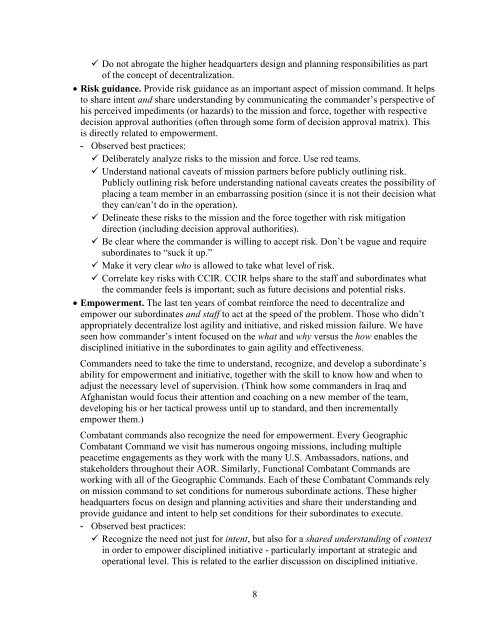Mission Command and Cross-Domain Synergy - Defense ...
Mission Command and Cross-Domain Synergy - Defense ...
Mission Command and Cross-Domain Synergy - Defense ...
- No tags were found...
Create successful ePaper yourself
Turn your PDF publications into a flip-book with our unique Google optimized e-Paper software.
Do not abrogate the higher headquarters design <strong>and</strong> planning responsibilities as partof the concept of decentralization.• Risk guidance. Provide risk guidance as an important aspect of mission comm<strong>and</strong>. It helpsto share intent <strong>and</strong> share underst<strong>and</strong>ing by communicating the comm<strong>and</strong>er’s perspective ofhis perceived impediments (or hazards) to the mission <strong>and</strong> force, together with respectivedecision approval authorities (often through some form of decision approval matrix). Thisis directly related to empowerment.- Observed best practices: Deliberately analyze risks to the mission <strong>and</strong> force. Use red teams. Underst<strong>and</strong> national caveats of mission partners before publicly outlining risk.Publicly outlining risk before underst<strong>and</strong>ing national caveats creates the possibility ofplacing a team member in an embarrassing position (since it is not their decision whatthey can/can’t do in the operation). Delineate these risks to the mission <strong>and</strong> the force together with risk mitigationdirection (including decision approval authorities). Be clear where the comm<strong>and</strong>er is willing to accept risk. Don’t be vague <strong>and</strong> requiresubordinates to “suck it up.” Make it very clear who is allowed to take what level of risk. Correlate key risks with CCIR. CCIR helps share to the staff <strong>and</strong> subordinates whatthe comm<strong>and</strong>er feels is important; such as future decisions <strong>and</strong> potential risks.• Empowerment. The last ten years of combat reinforce the need to decentralize <strong>and</strong>empower our subordinates <strong>and</strong> staff to act at the speed of the problem. Those who didn’tappropriately decentralize lost agility <strong>and</strong> initiative, <strong>and</strong> risked mission failure. We haveseen how comm<strong>and</strong>er’s intent focused on the what <strong>and</strong> why versus the how enables thedisciplined initiative in the subordinates to gain agility <strong>and</strong> effectiveness.<strong>Comm<strong>and</strong></strong>ers need to take the time to underst<strong>and</strong>, recognize, <strong>and</strong> develop a subordinate’sability for empowerment <strong>and</strong> initiative, together with the skill to know how <strong>and</strong> when toadjust the necessary level of supervision. (Think how some comm<strong>and</strong>ers in Iraq <strong>and</strong>Afghanistan would focus their attention <strong>and</strong> coaching on a new member of the team,developing his or her tactical prowess until up to st<strong>and</strong>ard, <strong>and</strong> then incrementallyempower them.)Combatant comm<strong>and</strong>s also recognize the need for empowerment. Every GeographicCombatant <strong>Comm<strong>and</strong></strong> we visit has numerous ongoing missions, including multiplepeacetime engagements as they work with the many U.S. Ambassadors, nations, <strong>and</strong>stakeholders throughout their AOR. Similarly, Functional Combatant <strong>Comm<strong>and</strong></strong>s areworking with all of the Geographic <strong>Comm<strong>and</strong></strong>s. Each of these Combatant <strong>Comm<strong>and</strong></strong>s relyon mission comm<strong>and</strong> to set conditions for numerous subordinate actions. These higherheadquarters focus on design <strong>and</strong> planning activities <strong>and</strong> share their underst<strong>and</strong>ing <strong>and</strong>provide guidance <strong>and</strong> intent to help set conditions for their subordinates to execute.- Observed best practices: Recognize the need not just for intent, but also for a shared underst<strong>and</strong>ing of contextin order to empower disciplined initiative - particularly important at strategic <strong>and</strong>operational level. This is related to the earlier discussion on disciplined initiative.8
















